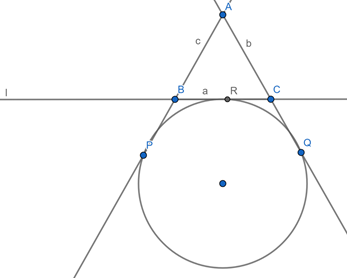In figure 11.24, two tangents are drawn to a circle from a point A which is in the exterior of the circle. The points of contact of the tangents are P and Q as shown in the figure. A line 1 touches the circle at R and intersects ![]() and
and ![]() in B and C respectively. If AB = c, BC = a, CA = b, then prove that
in B and C respectively. If AB = c, BC = a, CA = b, then prove that
(1) AP + AQ = a + b + c
(2) AB + BR = AC + CR = AP = AQ = 

Given that AP and AQ are tangents to the circle.
A line l touches the circle at R and intersects AP and AQ in B and C respectively. And AB = c, BC = a, CA = b.

We have to prove that
(1) AP + AQ = a + b + c
(2) AB + BR = AC + CR = AP = AQ = ![]()
Proof:
By theorem,
AP = AQ, BP = BR and CQ = CR … (1)
(1) AP + AQ = (AB + BP) + (AC + CQ)
= (AB + BR) + (AC + CR) [From (1)]
= AB + AC + (BR + CR)
Since B – R – C,
⇒ AP + AQ = AB + AC + BC
= c + b + a
∴ AP + AQ = a + b + c … (2)
(2) AB + BR = AB + BP [From (1)]
= AP [∵ A – B – P]
= AQ [From (1)]
= AC + CQ [∵ A – C – Q]
= AC + CR [From (1)]
∴ AB + BR = AC + CR = AP = AQ … (3)
From (2),
⇒ AP + AQ = a + b + c
From (1),
⇒ AQ + AQ = a + b + c
⇒ 2AQ = a + b + c
⇒ AQ = ![]()
From (3),
∴ AB + BR = AC + CR = AP = AQ = ![]()
Hence proved.